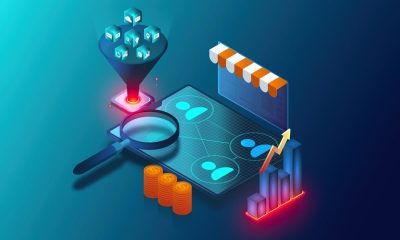General Advice
AI in SMEs: How to Prepare for the Future of Work?

Artificial intelligence is transforming the way different businesses operate, and that’s just the beginning of AI revolution. Many business owners are brainstorming whether there’s a place for AI in SMEs, and how it will shape the future of work and employment in those businesses.
Many people are concerned that with rapid AI development, roles and professions that are today crucial to businesses will become obsolete. That’s not without a reason because of the way AI is being promoted in media and the fact it can simplify so many daily tasks that’d normally take hours.
New AI tools emerge every day, from OpenAI’s ChatGPT and Google Bard to thousands of other AI-powered tools that can generate images, videos, summarize meetings, YouTube videos, and even write a research study.
According to research published by Jobbio, many people who are employed full-time are scared of the potential threat of AI for their jobs. According to data obtained for the research, around one-fifth of workers in The USA think that their jobs will no longer exist within the next ten years.
Instead of looking at it as a threat, small to medium enterprises should look for ways to implement AI in a way that can help them organize their workflow and improve productivity. Continue reading to learn how to use AI in SMEs to prepare for the future of work.
5 Ways to Use AI in SMEs to Prepare for the Future
As of 2022, there are 5.5 million SMEs in the UK, which makes up about 99.9% of the private sector, according to government data. Here’s how to leverage AI in SMEs and make better results.
Invest in AI Training
To use AI effectively the members of your organization will need to learn how to use it properly. You can do this through workshops, crash courses, bootcamps, and other forms of education. All SMEs should prioritize education and training within their workforce.
Developing AI literacy among your employees is the crucial step towards the effective use of AI in SMEs because it can help them identify where AI adds the most value to their work. This initiative can help foster innovation, identify AI use cases and cultivate a culture of continuous learning.
Maximize Workflow Automation
Many tools in the past allowed employees to automate their workflow, making it more effective. However, the integration of different AI tools available on the market can help maximize it. That said, AI in SMEs is quite important for automation.
According to research by Accenture, people will be able to focus on “exceptional work” which includes the non-routine tasks that generate more than 80% of value. In other words, the use of AI surpasses the traditional automation tools used in the past.
With the ability to automate even more tasks, even the non-routine ones, employees will be able to increase efficiency and focus on more strategic and creative endeavors.
Prioritize Data-driven Decision Making
AI is powered by data, and as such, it can help SMEs use it to make informed, data-driven decisions. But, to use business data as fuel for AI, businesses need to recognize the value in data and establish robust data management practices and policies.
SMEs can use data to get insights into customer behaviors and predict market trends as well as operational flaws and inefficiencies that maximize the loss and hold the company back from reaching its objectives. Using AI to identify potential security and privacy flaws can help establish firm security and privacy measures and adhere to data regulation.
That way, AI in SMEs can help build customer and stakeholder trust.
Invest in an Open AI Culture
SMEs shouldn’t see AI as a threat to job security but rather foster an open AI culture among teams and other employees.
It’s important to foster a culture where both humans and machines collaborate, making the job smoother, more effective, and more efficient. AI is designed to augment human performance and allow employees to work smarter while identifying weaknesses they can address to turn into strengths.
SMEs should encourage employees to explore the capabilities of AI and different AI-fueled solutions that can complement their work performance. AI in SMEs can lead to innovative and creative solutions as well as increased productivity which can be used for projects in the future.
Automate the HR
Have you ever heard of the term HAIR? It refers to automated human resources, leading to faster processing of large volumes of candidate data in efforts to find candidates that are more suitable for different positions.
It’s important to educate HR managers and the rest of the HR department on how to set an automated environment in a way that will allow them to analyze performance and other metrics regarding employment. HR managers will also need to analyze and explore ways to tell the AI performance apart from human work.
Conclusion
The AI revolution has started, and we’re yet to see the peak of AI in SMEs. One thing is for sure, SMEs will need to optimize AI in order to stay competitive in the market. The age of AI will bring even more SMEs forward that will know how to harness the power of AI to get on top of the industry.
By investing in AI education, training, and adaptability, and embracing automation SMEs will be more than prepared for the AI-driven future.
Opinion
How AI is Impacting Software Development Industry

In my tenure of nearly a decade in the software development field, I’ve seen small and medium business owners confront numerous challenging situations. The biggest challenge is competing with big companies while working with fewer people and less tech. This is where AI, or Artificial Intelligence, comes in.
In my own work, I’ve seen how AI can help small businesses do better. It can help us work faster, more easily, and save money. This article is about my experience with AI in software development. I’ll share how AI is changing the software field and how small businesses can use AI to improve their work.
Faster Work with AI
In my work as a developer, I’ve found AI tools can really speed things up. For instance, there was this one project where the deadline was tight. Using AI, we automated routine tasks like making code snippets and running tests. This freed up our time to focus on more important things. We finished faster than expected. I learned that small businesses can use AI to keep pace with big companies.
But, it’s not all smooth sailing. AI has its flaws. It’s like the time when I used an AI tool to generate code for a complex project. It ended up with errors and didn’t quite fit the project’s needs. So, I learned that while AI is helpful, we must always check the quality of the code it produces. Even though AI helps us work faster, we still need experienced developers to go over the AI-made code and make it better. I’ve found that this teamwork approach with AI makes sure the code is done right and keeps our standards high.
Making Reviews Easier with AI
AI is not just for coding. It also helps with reviewing work, but people don’t talk about this much. I remember using an AI tool called Reviewpad in one of my projects. It was pretty smart. It looked at past work to decide who should review new work, so the same person wasn’t always loaded with tasks. This made the review process faster. We could quickly finish reviewing, add the new code to the main project, and keep things moving.
By using tools like Reviewpad, small businesses can work better together. This is just another example of how AI is changing the way we work in software development.
Filling in Skill Gaps with AI
In traditional software work, developers handle most tasks like fixing bugs. But, some complex tasks need more experienced people, like Tech Leads or Software Architects. These include things like DevOps and serverless operations.
I remember working for a company that didn’t have many senior developers. They just started using Kubernetes and several other advanced DevOps tools. There was none who had experience with these technologies but a small team of developers started learning these technologies with the help of ChatGPT. It was surprising how much it helped. This team was able to handle the complete project with the help of any specific DevOps engineer.
With AI, small businesses can manage the challenge of skill gaps. They can rely less on senior developers. Overall, I notice that intermediate-level developers reap the greatest benefits from AI tools. Senior developers lose the advantage of having extensive experience, as AI tools can aid anyone in understanding complex technologies. On the other hand, entry-level developers might find it challenging to secure jobs, as AI tools can easily automate the tasks they are able to do. Ultimately, this situation will prove advantageous for intermediate-level developers, as most companies will be seeking their ability to do any job with the help of AI tools.
Finding Bugs and Smart Testing with AI
A big goal in making software is to give users a good product. But making sure the work is top quality can be tough. I’ve found that AI tools are a big help in this regard.
I was amazed at how fast AI tools could find problems in software and suggest how to fix them. There are AI tools that can find bugs in software applications that otherwise would need thousands of coded test cases. The fact that AI can find and fix problems early is a big plus for any small business.
Virtual Assistants and Intelligent IDEs
AI-powered virtual assistants and smart IDEs are becoming helpful tools for developers. They provide suggestions that fit the context, help with completing code, and generate code to boost developer productivity. By doing repetitive coding tasks and giving smart recommendations, AI tools allow developers to focus on more creative and challenging parts of software development.
Moreover, AI-powered virtual assistants can answer developers’ questions, supply references for documentation, and provide code snippets using natural language inputs. The assistance they provide in overcoming development hurdles, reducing development time, and improving productivity is significant.
From Analytics to Intelligent Insights
Data and AI are inseparable. AI can assist in decision-making by analyzing collected data. Thus, AI tools can also be used for decision-making in small and medium enterprises. This is another rarely discussed aspect of AI-based software tools.
One of the most tedious tasks in software development is data analysis. Now, this can be easily accomplished with the help of AI-driven analytics tools. These tools can process large volumes of data, identify patterns, and provide actionable insights based on them. These data-driven decisions can be massively leveraged to continuously improve software development processes.
Conclusion
In my view, AI is like a key that helps small businesses reach their goals more easily and effectively. From start to finish in making software – from figuring out what to build and writing it down, to coding and finding mistakes, to testing and making sure it’s top-notch – AI tools can help. They let small businesses keep up with bigger ones by making good software products fast.
But we have to be smart about using AI. Small businesses should pick the right AI tools, encourage teamwork between AI and human developers, and always make sure the quality of the work is top-notch. With AI, making quality software doesn’t have to be a hard task. It becomes something within reach.
AI Security
How AI Can Improve Customer Experience in SMEs

In today’s competitive business landscape, many small and medium businesses struggle to prioritize customer experience to leverage their products and services. With AI being one of the key assets for business growth in 2023, there are many ways to leverage AI to improve customer experience, sales, and productivity in your company. According to a report in Forbes, 64% of business owners think that AI can improve customer relationships. In this guide, we’ll talk about how AI can assist in the development and improvement of customer experience in SMEs and how your business can utilise it.
How AI Can Improve Customer Experience: 5 Ways
How we use customer and sales data depends on AI. The AI can help us collect customer data, as well as analyze it for better marketing and business strategies. Here are 5 ways that can help you improve customer experience with the help of machine learning and AI.
Data-driven Virtual Assistants
Implementing AI-powered VAs can be extremely valuable for the overall service your business provides. It can cut costs and reduce wait times so your customers and clients have faster access to solutions to their problems.
AI VAs can be available on multiple platforms and guide your customers to the solution to their issues. In case the issue is too complex, it can be referred to the human customer service agent.
Having a virtual assistant powered by AI can be a great asset for a business that operates globally and can help address overworked customer support agents that are often overwhelmed by the volume of work.
Chatbots
Another way how AI can improve customer experience in SMEs is by implementing chatbots on your website. It is another way to make it easier on customer service personnel, especially if your business is small and struggles to provide round-the-clock support due to limited resources.
Chatbots are already not uncommon, especially with service providers and online stores. But, with advanced AI systems based on LLMS (Large Language Models), they’re now even more improved, and able to converse almost naturally.
AI-powered chatbots can help you collect emails, appointment dates, order numbers, and other repetitive data, while your human customer service can focus on more time-sensitive and complex tasks.
Use Sentiment Analysis
Sentiment analysis is a powerful tool you can use when creating a marketing strategy for your business. It enables marketing managers to develop strategies that resonate with their potential customers and clients.
Understanding customer feedback is one of the best ways how AI can improve customer experience in SMEs. By identifying behavioral patterns and trends in customer sentiment, SMEs can proactively address issues and improve customer satisfaction.
Predictive Analytics for Demand Forecasting
AI can help SME owners analyse customer behavior and demand based on their previous purchases, shopping cart contents, wish list, and browsing patterns. Analysing this behaviour can also help managers choose the right time to start sales and introduce new products and services.
Predictive analytics is also helpful in providing businesses with valuable insights, allowing them to optimise inventory management and influence demand patterns. By leveraging AI’s predictive abilities, SMEs can reduce costs, improve resource allocation and enhance customer satisfaction.
Enhanced Cybersecurity Measures
If you’re wondering how AI can improve customer experience in SMEs by improving the cybersecurity of your website and other assets, it’s simply because customers will appreciate knowing that their data is safe and confidential.
Maintaining robust cybersecurity is crucial for protecting customer data and ensuring their trust in SMEs. AI can enhance cybersecurity measures by monitoring network traffic and identifying and mitigating potential threats. AI is also successful at detecting anomalies that can hint at security and data breaches.
By leveraging AI-powered security systems, SMEs can enhance their ability to protect customer data, ensuring top-notch customer experience.
Conclusion
AI enables SMEs to deliver tailored and seamless experiences to their customers and clients. By implementing chatbots and AI-powered virtual assistants, as well as a streamlined e-commerce experience, positive customer feedback and satisfaction are guaranteed. Identifying how AI can improve customer experience in SMEs is crucial for leveling the playing field and competing with larger enterprises while creating long-lasting customer relationships and trust.
AI Security
What Does AI Mean in the Context of Security?

As technology continues to advance, new threats are emerging all the time. Cyber attacks are currently a major source of concern for both individuals and enterprises. Anomalies, phishing, malware, and data breaches are just a few examples of cybersecurity attacks. While Security built on AI can protect you from these threats, how can these systems detect and stop malicious attacks?
In this article, we’ll learn about the challenges and solutions of AI in cybersecurity. Read on
The Role of Artificial Intelligence in Security Technologies
Artificial Intelligence is a powerful solution for detecting security-related threats, vulnerabilities and attacks. Modern technologies and security systems such as cyber incident response, home security systems, CCTV cameras, and credit card fraud detection use AI algorithms to keep their capabilities up to date. Security technologies utilize AI algorithms for multiple activities. These include recognizing patterns and signals, detecting unusual behaviour patterns, and searching for malicious activity. By incorporating AI, security systems can improve their effectiveness in various areas, and better protection against potential threats.
How AI can detect and prevent threats
AI has the potential to catch and prevent malicious threats.
- Defence Against Phishing Attacks – Just as AI makes everyday tasks painless, it also makes cybercriminal operations easier. Cybercriminals employ strategies to create phishing emails with accurate grammar and spelling. Phishing is an attack designed to steal sensitive data from a targeted company or a victim, such as a credit card or social security number. They may use deepfake audio or video to mimic a trusted individual and get their work merely by transferring funds into their account.
To protect against AI-powered phishing attacks, cybersecurity experts bring an upgraded algorithm to a system that focuses on recognizing patterns from vast piles and will detect unusual behaviour and anomalies. These AI algorithms should then be incorporated into every mobile phone, including offline devices. In addition, individuals and businesses are increasingly using deepfake detection tools that detect and combat deep fakes. These AI features make it valuable in detecting phishing emails, spam, and viruses.
- Network anomaly detection – Another vital point for using AI security in large-scale networks is monitoring and detecting abnormal patterns and behaviours. Without AI, this is just a complex task as well as a time-consuming process for humans.
For example, eExplainable Artificial Intelligence (XAI) techniques are an anomaly detection strategy that provides transparency and interpretability.
- Recognize zero-day threats – AI-powered threat intelligence platforms enhance the identification and mitigation of zero-day exploits. Attackers are utilizing unknown-natured zero-day attacks that include polymorphic worms, viruses, Trojans, network attacks, and other malware.
With AI, the analysis of data from many endpoints becomes quicker and more effective, enabling early detection of zero-day threats before an attack occurs. The AI-powered Intrusion Detection Systems (IDS) detect any unusual or malicious traffic over regular traffic entering a network.
- Maintaining signature-based malware defences up to date – AI can aid in the process of updating signature-based malware detection systems. Antivirus and firewall products follow signature-based detection techniques, an integral part of security systems. This makes it possible to stop risky actions before they can cause any damage.
- Monitors encrypted network traffic without violating privacy or encryption protocols – As people’s need for personal privacy and data protection increases, encrypted traffic has become prevalent in the cyber world. However, traffic encryption also protects against malicious and illegal traffic introduced by adversaries.
AI systems are trained to detect illegal traffic encryption and execute pattern recognition using advanced algorithms. As a result, AI-based techniques have emerged as an essential direction for detecting encrypted malicious traffic.
- Using GANs to generate realistic synthetic data for safe sharing – AI recommends generative adversarial networks (GANs) when data privacy is required and the generated data is vulnerable to attacks from savvy attackers. Synthetic data is an effective tool, especially when the required data is limited or there is uncertainty about how to share it with the concerned parties. The feature of GANs is to produce photorealistic pictures and videos. GAN is made up of two components, the generator, and the discriminator. The generator is responsible for creating new samples similar to the training data. On the other hand, the discriminator is responsible for separating the generated samples from the actual training data.
Cybersecurity training with AI reinforcement learning
Reinforcement learning is an independent, self-teaching system that practically learns by trial and error to achieve the best outcomes.
It is a machine-learning approach where the agents are taught to make a series of decisions. From this training, models or agents can obey instructions, perform tests, operate equipment, and much more.
For example, we may teach an RL agent to perform a penetration test or “hack” an API. Organizations can use this technology to both proactively and reactively assess the security of their apps. Gamification is a well-known example of reinforcing learning since it offers actual or virtual rewards to acknowledge positive security actions taken by employees. It can make security entertaining and even competitive.
Addressing Security and Privacy Challenges in AI Applications
Due to the risk of data breaches and cyberattacks on the ethical implication of AI decision-making, we must cooperate to understand and avoid the risks of AI despite reaping its benefits.
- One of the most serious problems regarding AI’s privacy and security is the handling of personal data. If it’s not managed correctly, it could lose sensitive information in the wrong hands, thus, it will become a panic situation.
- Another problem is the possibility of hacking or manipulation of AI systems. As AI systems become more complex and independent, cyber-attack threats arise.
- Apart from security concerns, there are some ethical concerns regarding AI decision-making. AI systems can make biased or prejudiced decisions that may result in biased cures of people, and groups, worsening existing social inequities.
To conquer these challenges, the AI system should build with a solid foundation of privacy and security standards. It should contain personal data security standards such as encryption & secure data storage and strategies for dealing with data breaches and cyberattacks. It is also important that AI decision-making systems are transparent and responsible to detect and settle discrimination.
Conclusion
Artificial Intelligence is an effective technique for finding vulnerabilities, threats, and attacks in the cyberspace environment. Security-specific AI can continuously detect and analyze massive amounts of data, look for malicious activity, and provide necessary solutions. However, while there are tons of benefits of AI, it is inherently susceptible to data poisoning and manipulation, which compromises the integrity of its systems. Therefore, the system must improve AI effectiveness by doing the appropriate tasks on a regular basis, such as updating algorithms, adding new and fresh data, and refining current data.












